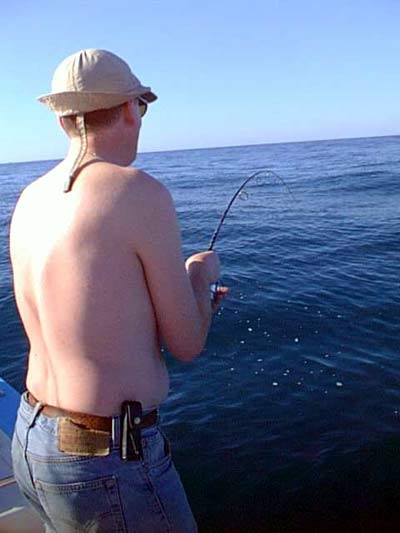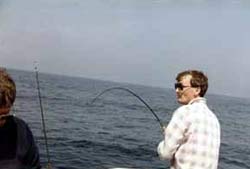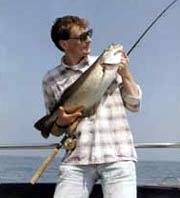| The Jeremy Airey Guide to FIGHTING that fish A few month’s back I ‘penned’ a piece praising (or not) the fighting qualities of various fish. This was a personal view on a very individual subject and I enjoyed reading all the posts on the FM Forum afterwards.
Fish Fighting Tackle Before going on to actual techniques let’s examine what I think are the tools we need to EFFECTIVELY fight a fish. A couple of things to remember here I’m only writing about the fish fighting end of things, not the casting and presentation side AND when all is said and done once again these are my preferences not a God given absolute. The Rod
I do appreciate that personal preference can play a big role in rod choice so having said that let’s move on. The Reel Also having a lot of ball bearings to smoooooth(sic) out line recovery under load is a big plus too. I think with reels you basically get what you pay for so buy the best you can afford and look after it. The above applies to all reel types including flyreels without clutches and centrepins where your fingers are, in essence, the drag. The Line The Hook Let Battle commence Your aim should be to get that fish beaten and returned asap and in as good nick as possible. I think this is best accomplished by being as FIRM as you can, short of pulling the fish’s head off. I am not an exponent of the let the fish run around and exhaust itself school of fish playing, I reckon you should get ‘stuck in’ and, more important, dictate the battles strategy as much as Mr Fish allows you to. You also need ‘Hands’ which, unless you are a direct descendant of a God, can only be gained through experience. ‘Hands’ is the ability to do what is necessary with due alacrity and smoothness, ie, increasing pressure smoothly if a fish that needs stopping when running for a snag or applying extra pressure to a running fish. Okay, so you hooked your fish which, being antisocial, and not a little PO’d, is running for the next county. Your drag has previously been set appropriately for the tackle being used, experience has taught me that common sense rules here rather than any formula dictated by rod action or test curve. But remember, a little drag at the reel end can have a big influence at the ‘fish’ end.
This next thing I do goes a little against the norm when I say I think the rod should be pointed down line, still held high and bent deep into the butt. A ‘high’ rod angle is not necessary or desirable at this stage – trust your ‘hands’ and your clutch to do their thing! The time for you to begin work is when the fish stops running. If possible get the fish’s head turned towards you and keep it that way because then every beat of it’s tail takes it nearer to you. I always pump the fish – short pumps at first then getting longer as the fish gets nearer and tires or throws in the towel. If the fish decides to jump lay the rod over to one side or the other, keeping the line out of harms way and close and parallel to the water – this eases strain on the hookhold and the line and if done at the apex of the fish’s jump can disorientate the fish somewhat. Try it on the next pike or rainbow that goes aerial and see what I mean. Mostly, one of two things happen now: the fish either comes straight in or, more likely, you are unable to completely turn its head and it starts to kite off to the side. Kiting is the resultant action of you pulling one way and the fish another. If you change the angle of pull you should be able to steer the fish in something like the direction you want it to go or, more to the point, away from where it wants to go! This all sounds peachy on paper but is obviously not so easy in practice. One tip is to remember you can use a combination of side and vertical or downward pressure. Also remember by lifting the rod horizontally while keeping the line angle the same you also ‘put it to’ the fish a little more as you increase friction of line against the rod rings – yes even with silicone lined rings. Now the fish is almost within netting distance take your time as some fish love to slug it out under the rod tip. Impatience will cost big time and only gets you pulled hooks and bust lines, I’m sure we’ve all been there and done that! If possible, especially from a boat, although it works on the bank too, I will put the reel in free-spool or engage the baitrunner or turn off the anti-reverse on a fixed spool and apply firm pressure with my non-winding hand hand. You really do need those ‘hands’ now. This action counters any sudden dives or runs the fish might make in this ‘close-up and personal’ situation – it is the work of a moment to re-engage the reels drive usually you just have to touch the handle. I know this sounds weird and maybe a bit unnecessary but it works very well and will mean fewer lost fish. All being well you should now be able to land your prize. Now bring up your best smile and get out the camera – you are a star! If I may give one piece of final advice, try to stay as calm and focused as possible and save the ‘nervous fruit jelly’ routine till the fish is returned. Do I take that advice ….. What do you think?! I hope the above is of interest and help to some of you as it represents a lot of what I have learned by experience about fish fighting in 35 years of fishing. It is only intended as a guide not a ‘bible’. If you want more specialised tactical advice try Graham’s articles in Coarse Fisherman on topics such as Snag Fishing and Reel Drags – all good stuff. Please post your comments through the forum link below. |
Welcome!Log into your account













